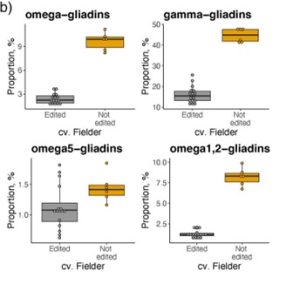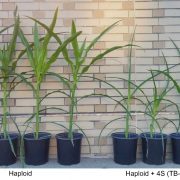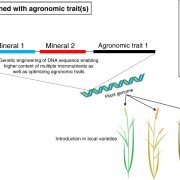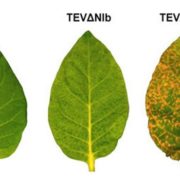Engineering wheat to reduce the immunoreactivity of gluten
 Some people cannot eat wheat because they are sensitive to gluten, which is a proteinaceous network of glutenins and gliadins. Gliadins are divided into four classes, ω, γ, α, and β, with ω- and γ-gliadins being the most toxic to gluten sensitive individuals. Hence, there is interest in reducing ω- and γ-gliadin content. Here Yu et al. annotated 9 functional ω-gliadin and 22 functional γ-gliadin genes in the genome of the wheat cultivar Fielder. Using these annotations, they designed seven guide RNAs (gRNAs) to target all the ω-gliadin genes and some of the γ-gliadin genes. The gRNAs and a Cas9 construct were transformed into Fielder by biolistic transformation. Whole genome sequencing identified a transgene free wheat line with deletions in all ω-gliadin genes and 55% of the γ-gliadin genes. This caused a 75% reduction in ω-gliadin and a 64% reduction in γ-gliadin protein abundance. More importantly, this led to a 42-47 fold reduction in immunoreactivity to antibodies which recognise toxic epitopes. This does not quite reach levels to be consumed by those who are gluten sensitive, but reducing ω- and γ-gliadin content even further could be a promising strategy for generating wheat that is safe for gluten sensitive individuals. (Summary by Rose McNelly @Rose_McN) Plant Biotech. J. 10.1111/pbi.14231
Some people cannot eat wheat because they are sensitive to gluten, which is a proteinaceous network of glutenins and gliadins. Gliadins are divided into four classes, ω, γ, α, and β, with ω- and γ-gliadins being the most toxic to gluten sensitive individuals. Hence, there is interest in reducing ω- and γ-gliadin content. Here Yu et al. annotated 9 functional ω-gliadin and 22 functional γ-gliadin genes in the genome of the wheat cultivar Fielder. Using these annotations, they designed seven guide RNAs (gRNAs) to target all the ω-gliadin genes and some of the γ-gliadin genes. The gRNAs and a Cas9 construct were transformed into Fielder by biolistic transformation. Whole genome sequencing identified a transgene free wheat line with deletions in all ω-gliadin genes and 55% of the γ-gliadin genes. This caused a 75% reduction in ω-gliadin and a 64% reduction in γ-gliadin protein abundance. More importantly, this led to a 42-47 fold reduction in immunoreactivity to antibodies which recognise toxic epitopes. This does not quite reach levels to be consumed by those who are gluten sensitive, but reducing ω- and γ-gliadin content even further could be a promising strategy for generating wheat that is safe for gluten sensitive individuals. (Summary by Rose McNelly @Rose_McN) Plant Biotech. J. 10.1111/pbi.14231









